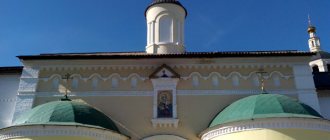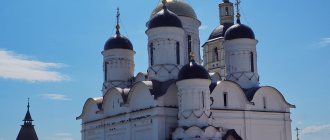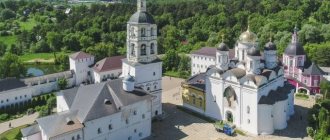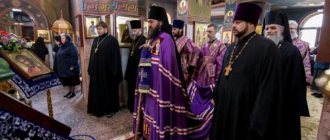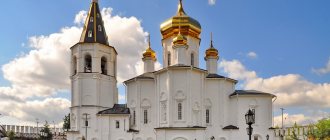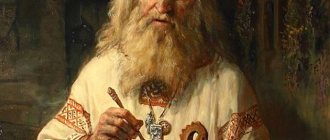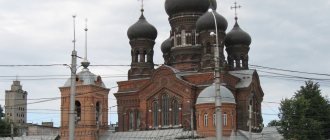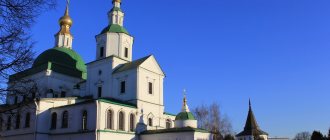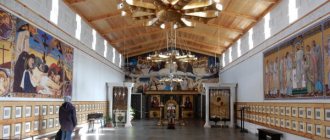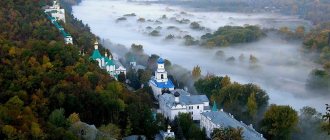There are many shrines and miraculous places in our country, but the fame of the Pafnutiev-Borovsky Monastery resounds far beyond its borders. I’m lucky that I live very close to this wonderful place in the Kaluga region, so I’ve been here more than once.
It is worth noting that the town of Borovsk, next to which the Paphnutian Monastery is located, is famous for its ancient architecture, modern frescoes on the walls of houses and other beauties. In addition, this place is home to many religious shrines and museums.
I would like to start my story from the Borovsk outskirts. Indeed, back in 1414, a young man named Parthenius came to this wonderful and secluded place, located on the banks of the Protva River. Here, in the Vysoko-Pokrovsky Monastery, he took monastic vows with the name Paphnutius and began his service to God and people.
And after another 30 years, the Monk Paphnutius retired to seclusion several miles from his first monastery. Exactly on the spot where the St. Paphnutian Monastery is now located.
Visiting Saint Paphnutius
And here is another trip to the Borovsky Monastery. Perhaps the great ones are right when they say that there can be no future without the past. Therefore, every ancient building, no matter whether religious or not, must be preserved for posterity.
Currently, this monastery combines a whole complex of church buildings of various styles and times.
In fact, the Holy Paphnutian Monastery is now not only a place of worship for Orthodox Christians, but also an architectural museum, where crowds of tourists, pilgrims and beggars flock daily, begging for alms right at the entrance.
And there is something to see here! When on the green bank of the river a white wall with narrow loophole windows grows right in front of you,
whose reflection bathes in water,
and the golden domes of the temples burn high in the sky - your heart skips a beat.
What is
This is a well-preserved monastery-fortress, the walls of which have been completely preserved. It should be understood that initially there were no tents on the towers, and if you look closely, you can see the characteristic “dovetails” right under the wooden tents, which surrounded the open combat area.
Well, inside there are cells, several churches and even, as I understand it, a refectory designed for pilgrims.
A look into the past
The monastery was founded in 1444, when the monk Paphnutius, leaving the monastery of the Intercession, accompanied by a student, went to seek solitude. Following him was a string of faithful followers who wanted to share his fate with the elder.
Little by little, the hermitage was transformed into a men's monastery, now known as the Pafnutiev Monastery of the Nativity of the Blessed Virgin Mary. The monastery was often visited by the powers that be: great princes and kings, the top of the Orthodox clergy. Each of them did not skimp on donations, which made it possible to complete the construction of more and more churches, walls and towers.
In May 1477, Saint Paphnutius died and was buried here, at the southern gate of the main cathedral of the monastery. After his death, the elder was canonized and canonized; his relics are still in the place of rest to this day.
The rich courtyard and enemies did not ignore it. Twice the Borovsky monastery was devastated and burned.
The first time this happened was in 1610 by order of False Dmitry II, then in 1812 during the war with the French. But each time the St. Borovsky Monastery was restored, life went on.
With the advent of Soviet power in 1919, the brethren were expelled from their native walls, and the monastery was declared a national monument. Another 70 years have flown by. During this period, the buildings were not used at all for their intended purpose. In 1942 they were retrained into the Political Directorate of the Western Front. And later an agricultural technical school was located here.
And only in 1991 the Borovsky Monastery was returned to the Orthodox diocese and regained its former status. The churches were re-consecrated, priests and parishioners returned to them, and services were resumed.
Story
The year of foundation of the monastic monastery is considered to be 1444. It was in this year that the Monk Paphnutius and a group of followers settled on a hill at the confluence of the Isterma River with Protva. Over time, word of the monastery spread; people from nearby settlements began to come here for services and prayers.
After some time, the hermitage became a full-fledged monastery. In 1467, on the site of the old wooden church, the first stone structure was erected - the Nativity Cathedral. More than a hundred years later (in 1586), the temple was demolished, and a new, five-domed one was built in its place. During construction, painted elements from the previous building were used. Since the 16th century, the monastery has been overgrown with walls and fortifications, which did not always save it from destruction and burning during foreign raids. At the end of the Time of Troubles, the territory began to be restored, including the towers and walls.
With the arrival of the Bolsheviks, all property was transferred to the Main Museum. The territory housed a correctional colony, and later an agricultural technical school. For a long time, the monastery belonged to the Borovsky Local History Museum.
The revival of the monastery and its transfer to the Russian Orthodox Church took place only in 1991. Since then, the monastery complex has completely resumed its usual life - its doors have opened to parishioners, and services have begun to be held in churches. In the 1990s, many other positive events took place - the Church of the Prophet Elijah was revived, the Church of the Holy Great Martyr Irene was opened, and the bells were again raised to the bell tower.
Territory and temples
The territory of the monastery is well-groomed, surrounded by greenery, flowers and trees.
Very close by, behind the wall, a river gurgles and there is a pond, which once served as a source of drinking water.
Fortress wall
What is impressive at first glance: the entire courtyard is surrounded by a high fortress wall,
into which several different-sized towers are built.
Each has its own name: Round, Armory, Povarennaya, Georgievskaya, Storozhevaya and Taynitskaya. The wall was built over the course of the 16th and 17th centuries, its thickness is not the same everywhere, the average is 4 m, length 673 m.
This is not just a decorative element. The wall was supposed to perform a protective function and for this purpose it was equipped with embrasures for cannon and rifle combat. As they say, trust in God, and don’t make a mistake yourself!
And from the inside of the fortress wall you can walk along a long corridor.
Is it true. the passage is currently closed to visitors.
The main temple of the Borovsky monastery
To date, not all churches have survived on the territory of the St. Pafnutevsky Monastery. For example, the Church of All Saints, which stood from 1838 to 1930, was destroyed. But the white stone Cathedral of the Nativity of the Virgin Mary, which was founded under Tsar Fyodor Ioannovich in 1586, was perfectly preserved.
The yellow-white temple with majestic onion domes is surrounded on both sides by chapels named after Theodore Stratelates and the Great Martyr Irene. The building is deliberately placed in an open space, which emphasizes its austere beauty.
An interesting fact: the foundation was based on blocks with frescoes from the 15th century, which allowed several local history museums to acquire fragments of paintings by the icon painter Mitrofan himself and his assistant Dionysius during restoration work.
There is a legend that previously there were underground passages from the Church of the Nativity through which one could get to Kaluga and Moscow. And this was done so that the monks could overcome this long path in solitude, being in prayer and not being distracted by the temptations of the world around them.
The main shrine of the Nativity Church, of course, is the shrine with the relics of St. Paphnutius of Borovsky. It is located near the altar, on the right. In the main chapel, in gilded cases, there are miraculous icons of the Mother of God. There are always a lot of fresh flowers near them. And under the glass are a wide variety of decorations and jewels that believers bring as gifts to the Mother of God for the speedy hearing of their prayers.
There are also several caskets in the temple, which contain particles of the relics of many Orthodox saints.
Hospital Temple of the Prophet Elijah
The small building of the Temple of the Prophet Elijah adjoins the premises that previously housed a hospital ward, a refectory and a kitchen.
The lattice separating them allowed patients undergoing treatment to attend church services. Nearby there is a cemetery where soldiers who died during the War of 1610 were buried.
Mitrofan's Church
No less interesting is the Mitrofan Church. The one-story church building was erected in 1760 and is one of the latest architectural structures of the Pafnutievo-Borovsky Monastery. Its crown with a cross rises to a height of 30.5 m, pleasing the eye with the purity of its lines.
The Church of St. Mitrofan is connected to the abbot's building, from where you can get to the temple without going outside.
Previously, the temple was surrounded by a porch on three sides, now only the porch on the south side reminds of this.
In the basement there is a resting place for all the abbots of the monastery. An arch located on the side of the church leads to the crypt room.
Bell tower
The bell tower can be called a real miracle of Russian architecture.
An airy, snow-white building 55 m high, decorated with semi-columns, semicircular high windows and bas-reliefs in the form of seraphim and fruits.
There is also a tower clock installed here, the ancient mechanism of which has long been replaced with a modern, electronic one, but on the outside everything looks the same, preserving the spirit of antiquity.
The Museum of Russian Icons is located in the basement; in one of its rooms you can see unique medieval frescoes. This is a heritage carefully preserved for our descendants.
And on the other side of the bell tower, if you go from the street under the arch and go up to the 2nd floor, there is a huge icon shop, where a huge selection of icons, Orthodox literature, audio and video recordings and other paraphernalia is presented.
There is also a food kiosk next to the bell tower. This is where you can buy monastery bread, the aroma of which is in the air.
Despite the fact that all the temple buildings and ancillary premises were built at different times, in general they create a surprisingly harmonious impression.
Paradise
And behind the main Nativity Church of the St. Paphnutyev Monastery, a truly paradise has been recreated. And you can enter it along beautiful marble steps through an openwork arch.
And now you find yourself in a very cozy gazebo, decorated with bright and fragrant flowers.
A little further away there is a carved wooden feeder, and nearby there are beautiful lawns.
Hidden between the trees is a cute fountain with kissing doves.
Here you simply forget about the passage of time, as if it stops. And only cats scurrying around, raising their pointy-eared muzzles up, destroy the charm of sleep, causing smiles.
Moreover, the aromas of herbal tea, bread and pastries floating through the air invite you to take a break and have a snack. This is such a funny transition to reality.
Holy Elder
Many believers come to the Borovsky Monastery in the hope of the help of the elder - the local confessor, Father Blasius. They say that this person is able to help with family troubles and health problems. Many believe him and strive to go to confession.
We failed to see this enlightened man. Yes, it’s not so simple: many people come to see Father Vlasiy for advice and consolation. And often people wait more than one day for their turn.
They also say that it was he who became the prototype of Father Anatoly from Pavel Lungin’s film “The Island”.
Things to do
Personally, I was interested in this place for a “pure look.” I mean, look at the architecture. And in this capacity I quite liked the monastery. In its current form, it appeared in the 16th-18th centuries, and when examining individual churches from the ensemble, it is quite easy to determine which part belongs to which period - a very interesting task, I tell you. In the video that I provided at the very beginning, this point is covered in sufficient detail.
Holy spring
But this is a sad section in this article, since I will have to write about something that currently (summer 2015) does not exist.
For many years, residents of all surrounding cities came to the holy spring of Paphnutius Borovsky to collect amazingly tasty and clean water.
A few years ago a wonderful font was built over the spring! Oh, and the water there was cold. It was breathtaking when we plunged headlong three times in the name of the Father and the Son and the Holy Spirit. And what long lines lined up here for Epiphany! People stood in the cold for several hours to plunge into the font and collect blessed Epiphany water.
It's hard to say what happened. But gradually the water pressure in the spring began to weaken. And now the source in its former place has completely ceased to exist.
But they say there is hope for recovery.
I offer everyone who wants to plunge into the holy font and draw spring water a wonderful place located a few kilometers from here. This is the Vysoko-Pokrovsky Church, which is the courtyard of the St. Paphnutev Monastery. It is quite deservedly also called Borovskie Kizhi.
How to get there
Finding out where the Borovsky Monastery is located and how to get to it is quite easy; there will be many signs along the way.
Personal car: along the Kievskoe highway to Balabanovo (about 90 km from Moscow), then drive towards Borovsk until the fork. We turn left, pass Rusinovo, then in Ryabushki on the left there will be a sign to the Borovsky Monastery.
There is free parking near the monastery. But it is worth considering that on weekends and holidays there are a lot of cars and excursion buses. So you can’t always count on being able to park close to the entrance to the monastery.
Coordinates: 55.21391, 36.53263.
You can get there from Moscow by public transport. Electric trains run from Kievsky Station to Maloyaroslavets or Kaluga. We get to Balabanovo station (just under 2 hours). Next, at the bus station we change to a bus or minibus to Borovsk. You need to get off at the “Ryabushki” or “Roshcha” stop, then walk.
And then our path lay to the city of Maloyaroslavets, where another ancient monastery with an unusual name is located: St. Nicholas Chernoostrovsky.
If you want to stay in these places longer, you can easily rent an apartment or a room on the Airbnb service, or through Booking book any hotel in nearby cities: Obninsk, Balabanovo, Borovsk, Maloyaroslavets or near them.
This trip took place on August 21, 2015. Read about other monasteries and churches that I was able to visit here. You can read about other attractions of the Kaluga region here. They are all marked on this map.
Write in the comments below which holy places you were able to visit and what made the strongest impression.
Borovsk Hotels
The distance between Moscow and Borovsk is determined automatically using algorithms and precise satellite GPS coordinates of cities, towns, points of interest and roads.
Our map shows the Moscow Borovsk highway - it is drawn with a red bold line. The nearest cities to the starting and finishing points of the route are also marked there. For your convenience, you can see traffic jams in Borovsk in real time on the map!
In order to find out how many kilometers from Moscow to Borovsk , we added up the lengths of all roads between the stated settlements.
